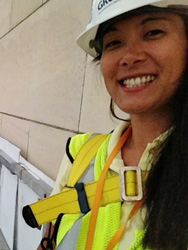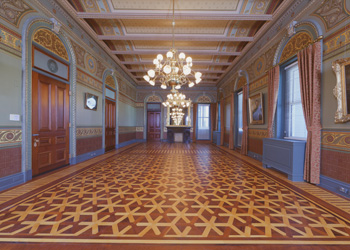Constance Lai - Historic Preservation Manager, Grunley Construction
 Constance Lai is the Historic Preservation Manager for Grunley Construction. She is a licensed architect and a LEED AP BD+C accredited professional. She has worked on the Eisenhower Executive Office Building and the Washington Monument and is currently working on the restoration of the U.S. Capitol. Her most recent publication, "Construction and Conservation Safety" was published in the American Institute for Conservation's September 2014 newsletter.
Constance Lai is the Historic Preservation Manager for Grunley Construction. She is a licensed architect and a LEED AP BD+C accredited professional. She has worked on the Eisenhower Executive Office Building and the Washington Monument and is currently working on the restoration of the U.S. Capitol. Her most recent publication, "Construction and Conservation Safety" was published in the American Institute for Conservation's September 2014 newsletter.
What led you to your field?
After receiving my Bachelor of Architecture from Rice University, I went to MIT where I earned a Master's degree in the History, Theory and Criticism of Architecture and Art program. The HTC program emphasizes historiography, philosophy, and analysis of the complex relationship between architecture and how society justifies and interacts with what it builds. While these two years at MIT were very transformative, I did not see myself pursuing an academic career; so, I decided to go back to the "real world" in 1999, where I worked for an architecture firm that specialized in transportation. After three years, I needed a change of pace and landed at a small historic preservation firm, Page and Turnbull, in San Francisco.
At the time, historic preservation was not even on my radar, but I quickly realized that the theoretical issues that I had contemplated during my graduate studies were being actively debated in this discipline. Which parts of a building are worth saving? Why? Do economic considerations trump aesthetic ones? Who decides the level of integrity of an element: the architect or the craftsman? Historic preservation is where theory meets practice on a daily basis, where compromise is a philosophical construct with real world implications, where budgets have cultural ramifications, and where history is literally written in stone. I was hooked!
In 2005, I moved to Los Angeles to work for Wiss, Janney, Elstner Associates, Inc. (WJE). I worked on historic preservation projects, but also on building envelope repairs and water infiltration litigation. Just like MIT, these two years in LA were eye-opening, but in a much different way. Instead of pondering the philosophical and cultural ramifications of physical structures, I was pondering the litigious and economic ramifications of physical structures that were not going to stand the test of time or nature. For two years, I worked on everything from poorly built high-rise condominiums to residential structures completely obliterated by Hurricane Katrina in New Orleans.
In 2007, I moved to Washington, D.C. to work on the Eisenhower Executive Office Building Modernization Project and then, in 2009, I decided to join the general contractor, Grunley Construction, where I still am today.
How does what you do relate to historic preservation?
Historic preservation as a discipline is dominated by activists, historians, architects and regulators, who set the agenda, write the history, design the "blueprints," and serve as society's stewards protecting our cultural resources. But, the actual preservation is done by the contractors who are paid to execute the repairs, replicate missing architectural features, and make the building functional again. As a general contractor, we manage all of the subcontractors that bring a structure back to life. We make sure that the client's wishes and architect's designs are executed properly, all while being sensitive to the existing historic fabric. On a daily basis, I work with our project managers, superintendents, estimators, specialty contractors, and clients, to ensure that everyone understands what needs to be preserved, restored, and/or replicated on any given construction project.
Why do you think historic preservation matters?
Historic preservation matters because it is a discipline that requires one to think critically about our built environment and grapple with the physical manifestations of our culture's values. Existing buildings embody former aesthetic values, former functions, former construction techniques, and most importantly, former histories. Note that I'm using the plural to denote the validity of all the histories of any particular building, no matter who the historical occupant or participant may have been, master or servant, host or guest, architect or construction laborer. All these histories are important and exist within a building. When we - as a society - decide to bring a building back to life, all of these former elements and histories come into play and inform how a building will be rehabilitated for contemporary use. It is a testament to our cultural values that we take time to evaluate the historic significance of our built environment before we start any preservation project.
What courses do you recommend for students interested in this field?
It is imperative to challenge yourself. If construction comes easy to you, force yourself to take architectural theory courses. If philosophy is a piece of cake, take a material science course. Also, Historic preservation will always play "second fiddle" to contemporary architecture, so it is important to not become a "relic" yourself! Spend time working on new buildings to understand the latest technologies and codes. There have been so many times that my knowledge of new construction has helped to preserve a building when the historic construction methods just weren't cutting it. Take biology, chemistry, structures, and courses in architectural conservation, sustainability, project management, and construction management. Finally, never stop being curious!
Do you have a favorite preservation project? What about it made it special?

Eisenhower Executive Office Building, Secretary of the Navy's Suite (Credit: Carol M. Highsmith Photography, Inc./GSA)
From 2007 through 2012, I worked on the Eisenhower Executive Office Building Modernization Project, providing historic preservation expertise and managing the restoration of the historic interiors. Our design-build team included architects, engineers, historic preservation specialists, specialty subcontractors, craftsmen, architectural conservators, decorative painters, and MEP (Mechanical, Electrical & Plumbing) contractors, just to mention a few! We had a great client, the GSA, who was committed to restoring as many spaces as possible back to their gilded Victorian Age grandeur. In 2014, the project was awarded the GSA Design Excellence Honor Award. What made the project special was not only the quality of the spaces that we were able to restore but also how everyone was committed to making the project the best it could be. It was a project of a lifetime that all of us who worked on it will always remember.
My second favorite project was working on the Washington Monument Earthquake Repairs project from 2012 to 2014. I lead the pre-construction survey team and also served as Quality Control Manager for the last four months of construction. It was breathtaking to ride the hoist up every day and just "hang out" on the swing stages, documenting all of the repair conditions. As an American, it was definitely an honor to work on the Washington Monument.
Can you tell us what you are working on right now?
Currently I am working on the Exterior Stone and Metal Preservation project at the U.S. Capitol, the Consumer Finance Protection Bureau Building, and various buildings for GSA, including the Department of the Interior Building. I'm constantly running around DC, overseeing the critical preservation and conservation aspects of all of these projects.
How do you think the national historic preservation programs help your community?
The majority of my projects are on federal buildings, so the Section 106 process factors heavily into how the projects are implemented. Since I work on the construction side, I'm ultimately responsible for executing the decisions that were made by the federal agency and their architect. On design-build projects, the architect is contractually one of our sub-contractors, so I aid the architect in finding appropriate preservation solutions. If it weren't for the framework that Section 106 provides, we wouldn't have the quality of preservation work that exists on these federal projects.
Do you have advice for novice preservationists?
Before going to graduate school, use your undergraduate student status to get the discounted registration rates for a few (if not all) of these annual conferences: National Trust for Historic Preservation, National Main Streets Conference, Association for Preservation Technology International, American Institute for Conservation of Historic and Artistic Works, Society of Architectural Historians, Vernacular Architecture Forum, and the Preservation Trades Network. It may seem like a lot, but these conferences represent the range of preservation careers that exist in the United States. Even if you know exactly what you want to do, it is important to know what makes all the other preservationists in this country tick.
The ACHP's mission is "preserving America's heritage;" can you give us an example of how your community is preserving its heritage?
For me, my community is my city, which is in turn my country. Working on the Washington Monument is the most obvious example of helping to preserve our nation's heritage, but I've also worked on buildings that house the Executive Branch, Legislative Branch, Secretary of the Interior, Smithsonian, U.S. Forest Service, Consumer Finance Protection Bureau, and Health and Human Services. Every day, I'm constantly reminded that I'm helping to preserve the heritage of this country by restoring the buildings of the stewards of our cultural heritage, our economic well-being, our health, and most importantly, our democracy.
Read more Q&A stories about the preservationists in your neighborhood!